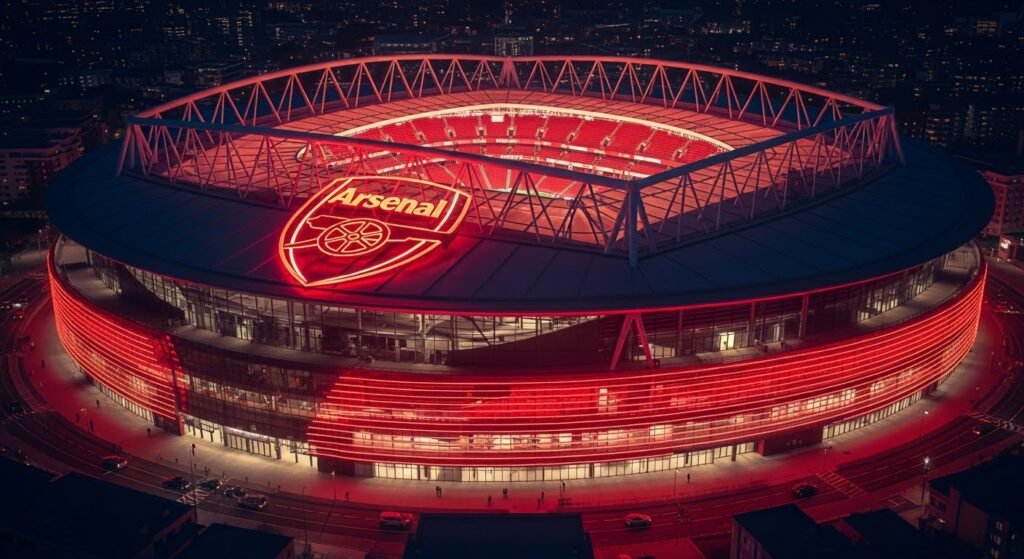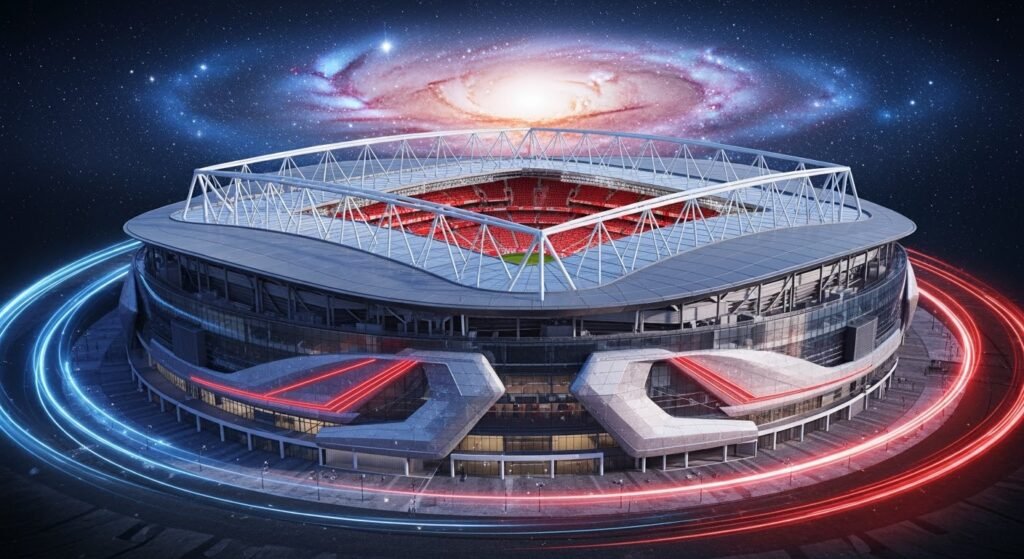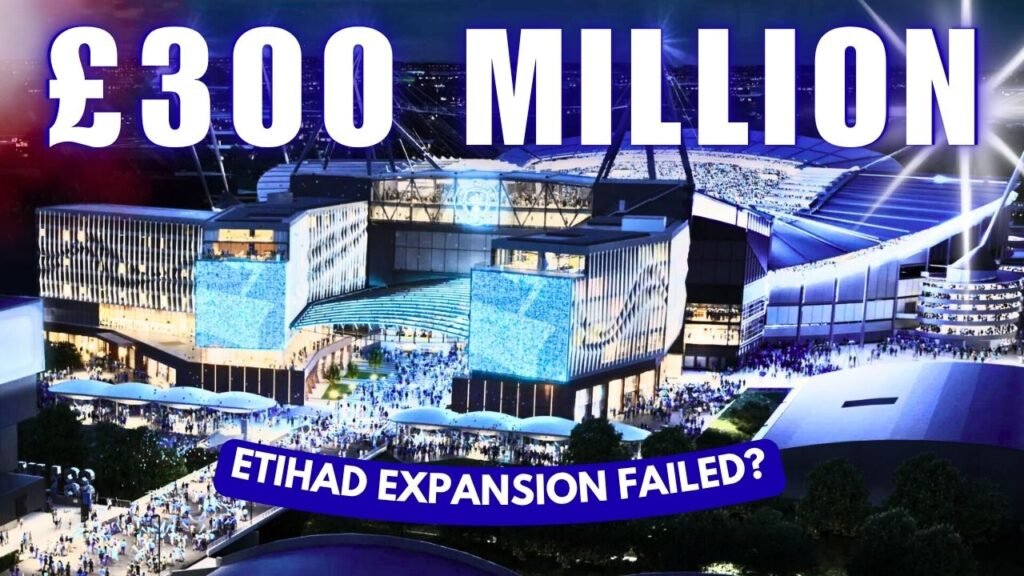Half a BILLION pounds. 80,000 seats. And a stadium transformation that could change Arsenal forever.
The Emirates Stadium is about to undergo one of the most expensive renovations in Premier League history, and what the Gunners are planning will blow your mind. We’re talking about a project that could cost MORE than it took to build the entire stadium in the first place. But here’s the thing… Arsenal NEEDS this to happen. And I’m going to show you exactly why.
While rivals are building super stadiums around them, Arsenal is in a race against time. Today, we’re going deep inside these expansion plans, the eye-watering costs, the massive challenges they’re facing, and whether this gamble will actually pay off.
This is the full breakdown of Arsenal’s Emirates Stadium expansion masterplan. Let’s get into it.
Watch Video:
THE REVENUE GAP

First, let’s talk about WHY Arsenal is doing this. Because right now, they’re leaving millions of pounds on the table every single season.
The Emirates currently holds 60,704 fans. That makes it the one of the largest stadium in England. Sounds impressive, right? But look at the competition:
- Old Trafford: 74,197
- Tottenham Hotspur Stadium: 62,850
- London Stadium: 62,500
- Anfield: 61,000+
Arsenal are being outgunned by their rivals. And in modern football, matchday revenue is extremely IMPORTANT.
Get this – Arsenal just hit £716.5 million in revenue, making them the Fourth richest club in the Premier League behind only Manchester City, Manchester United, and Liverpool. They’re seventh in the world according to the Deloitte Football Money League 2025.
But here’s the problem. While their revenue has exploded from £372 million just three seasons ago to potentially £700 million this season, their matchday income is capped. Every single home game, they’re turning away fans who want tickets. They’re literally at maximum capacity.
Meanwhile, Tottenham across North London? They’re raking in MORE matchday revenue with their 62,000-seat stadium because it was built for the modern era – premium seating, corporate boxes, NFL games, concerts, you name it.
ARSENAL’S EMIRATES STADIUM EXPANSION PLANS!

So what exactly is Arsenal planning? Buckle up, because this is ambitious.
Arsenal wants to transform the Emirates from 60,704 seats to a staggering 80,000-capacity fortress. That’s nearly 20,000 additional fans EVERY single match day.
Let’s do the math. If Arsenal hosts 19 Premier League home games, that’s an extra 380,000 tickets per season. At an average ticket price of £50 to £100, we’re talking an additional £19 to £38 MILLION per year just from league games. Add in cup competitions, European nights, and potential multi-use events? That number skyrockets.
But it’s not just about adding seats. The plans include:
Premium hospitality upgrades – because that’s where the real money is. These luxury boxes and premium seats can sell for thousands of pounds per match.
Modern facilities and infrastructure – the Emirates opened in 2006, and while it was cutting-edge then, stadium technology has evolved massively in the last 20 years.
Multi-use capability – think concerts, NFL games, other sporting events. Tottenham makes millions from hosting events beyond football.
The target completion date? 2028. Arsenal wants this finished within three years, which is an incredibly tight timeline for a project this complex.
But here’s where things get interesting – and expensive.
EXPECTED COST OF EMIRATES STADIUM EXPANSION
The Emirates Stadium expansion is widely expected to cost in the region of £400 to £500 MILLION pounds.
Think about that. The entire stadium was built in 2006 for £390 million. This renovation could cost MORE than the original construction. Why?
Three words: LOCATION, LOCATION, LOCATION. But not in a good way.
The Emirates sits on one of the tightest footprints in the Premier League. You’ve got Drayton Park railway station to one side, residential housing on another, major roads, underground stations – this stadium is boxed in from every angle.
Former Arsenal director Keith Edelman, who was there during the original build, recently warned the club about the problems they’re facing. And he knows what he’s talking about.
The club can’t expand outwards – there’s literally no room. So they have to build UPWARDS. Experts have said Arsenal would essentially need to ‘build another small stadium on top‘ of the existing structure.
That means:
Reinforcing the entire existing structure to handle the additional weight.
Maintaining the roof integrity while essentially rebuilding above it.
Doing all this while keeping the stadium operational for matches.
And here’s the kicker – they can’t just shut down the Emirates for two years. Arsenal plays 30-40+ home matches per season between the Premier League, cup competitions, and European games. That’s massive revenue they can’t afford to lose.
The solution?
They might have to use Wembley Stadium for some matches during construction, which adds even more cost and complexity. Imagine playing ‘home’ games in a neutral venue.
THE WOMEN’S TEAM FACTOR
But here’s something brilliant that makes this expansion even more valuable.
From the 2025-26 season onwards, Arsenal Women will permanently call the Emirates home for all their league matches.
They previously played at Meadow Park, which holds just 4,500 fans. The women’s team has been SMASHING attendance records, and they’ve consistently filled out their allocation at the Emirates for big games.
An expanded 80,000-seat Emirates means:
Arsenal Women can become the best-supported women’s team in the world. The potential for growth in women’s football is enormous, and Arsenal is positioning itself to dominate that market.
Dual usage maximizes the stadium investment. More matches, more revenue, better value for money from the £500 million spend.
This isn’t just good PR – it’s smart business. Women’s football is one of the fastest-growing sport in the world, and Arsenal is ahead of the curve.
COMPETITION & PRESSURE
Now, Arsenal isn’t working in a vacuum. The pressure is ON because everyone around them is making moves.
Manchester United just unveiled plans for a potential NEW 100,000-seat stadium to replace Old Trafford. Cost? Up to £2 BILLION.
Everton’s brand new 52,888-capacity stadium at Bramley-Moore Dock opens soon – a state-of-the-art facility built from scratch.
Liverpool continues upgrading Anfield, adding capacity and modernizing facilities.
Chelsea is exploring options for a new 60,000+ seat stadium.
Arsenal is in genuine danger of being left behind. In the modern football economy, stadium revenue is crucial for Financial Fair Play compliance and competing for top players.
To compete with Manchester City and Manchester United, Arsenal needs every revenue stream maximized. Champions League qualification brings in £100+ million. But you know what helps ensure Champions League football? Having the best players. And you know what helps sign the best players? Money.
Josh Kroenke, Arsenal’s co-chairman, confirmed they’ve held extensive conversations about stadium upgrades. The club has reportedly enlisted architects and is preparing to file official planning paperwork.
This is REALLY happening. We’re past the ‘maybe’ stage. Arsenal is committed.
CONCLUSION
So, will this £500 million gamble pay off?
If Arsenal can pull this off by 2028, they’ll have:
- An 80,000-capacity fortress generating £30-50 million in additional annual revenue
- State-of-the-art facilities rivaling any stadium in world football
- A permanent world-class home for both their men’s and women’s teams
- Multi-use capability for concerts and events
- A competitive advantage in the revenue race
But the challenges are real. The site is cramped, the engineering is complex, and half a billion pounds is a staggering investment.
However, Arsenal’s revenue has nearly DOUBLED in three years. The club is financially healthy. The Kroenke family is committed. And in modern football, you either invest or you fall behind.
The Emirates expansion isn’t just about seats. It’s about Arsenal’s ambition. It’s about declaring to the world: We’re here to compete at the very highest level.
One thing’s for certain – by 2028, the Emirates Stadium is going to look very, very different.
What do you think? Is £500 million worth it? Should Arsenal build a completely new stadium instead? Let me know in the comments below.
If you enjoyed this deep dive, smash that like button, subscribe for more football business breakdowns, and hit the notification bell so you don’t miss our next video.
I’ll see you in the next one.


